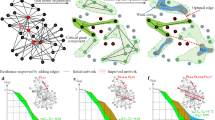Abstract.
Networks with a given degree distribution may be very resilient to one type of failure or attack but not to another. The goal of this work is to determine network design guidelines which maximize the robustness of networks to both random failure and intentional attack while keeping the cost of the network (which we take to be the average number of links per node) constant. We find optimal parameters for: (i) scale free networks having degree distributions with a single power-law regime, (ii) networks having degree distributions with two power-law regimes, and (iii) networks described by degree distributions containing two peaks. Of these various kinds of distributions we find that the optimal network design is one in which all but one of the nodes have the same degree, k 1 (close to the average number of links per node), and one node is of very large degree, \(k_2 \sim N^{2/3}\), where N is the number of nodes in the network.
Similar content being viewed by others
References
R. Albert, H. Jeong, A.-L. Barabási, Nature (London) 406, 378 (2000)
V. Paxon, IEEE/ACM Trans. Networking 5, 601 (1997)
R. Cohen, K. Erez, D. ben-Avraham, S. Havlin, Phys. Rev. Lett. 85, 4626 (2000)
D.S. Callaway, M.E.J. Newmann, S.H. Strogatz, D.J. Watts, Phys. Rev. Lett. 85, 5468 (2000)
R. Cohen, K. Erez, D. ben-Avraham, S. Havlin, Phys. Rev. Lett. 86, 3682 (2001)
R. Cohen, D. ben-Avraham, S. Havlin, Structural Properties of scale free networks, Chap. 4 in Handbook of Graphs and Networks, edited by S. Bornholdt, H.G. Schuster (Wiley-VCH, New York, 2002)
Note that we study here optimization of the case when the same network is subject to random failure or targeted attack but not combined random failure and targeted attack on the same network
A.-L. Barabási, R. Albert, Science 286, 509 (1999)
M. Faloutsos, P. Faloutsos, C. Faloutsos, Computer Communications Rev. 29, 251(1999)
A.-L. Barabási, R. Albert, H. Jeong, Physica A 281, 69 (2000)
A. Broder, R. Kumar, F. Maghoul, P. Raghaven, S. Rajogopalan, R. Stata, A. Tomkins, J. Wiener, Computer Networks 33, 309 (2000)
H. Ebel, L.-I. Mielsch, S. Bornholdt, Phys. Rev. E. 66, 128701 (2002)
S. Redner, Eur. Phys. J. B 4, 131 (1998)
H. Jeong, B. Tombor, R. Albert, Z.N. Oltvai, A.-L. Barabási, Nature 407, 651 (2000)
S.N. Dorogovtsev, J.F.F. Mendes, Evolution of Networks: From Biological Nets to the Internet and the WWW (Oxford University Press, Oxford, 2003)
R. Pastor-Satorras, A. Vespignani, Evolution and Structure of the Internet: A Statistical Physics Approach\/ (Cambridge University Press, 2004)
In order to keep \(\langle k \rangle\) constant, as we change \(\lambda\) we also must change m, the minimal number of links a node can have. Note that the value of m decreases as we increase \(\lambda\)
We obtain similar results for other values of \(\langle k \rangle\)
P. Erdös, A. Rényi, Publications Mathematicae 6, 290 (1959)
P. Erdös, A. Rényi, Publications of the Mathematical Inst. of the Hungarian Acad. of Sciences 5, 17 (1960)
B. Bollabas, Random Graphs (Academic, London, 1985)
L. Braunstein, S.V. Buldyrev, R. Cohen, H.E. Stanley, Phys. Rev. Lett. 91, 168701 (2003)
A.X.C.N. Valente, A. Sarker, H.A. Stone, Phys. Rev. Lett. 92, 118702 (2004)
Author information
Authors and Affiliations
Corresponding author
Additional information
Received: 20 January 2004, Published online: 14 May 2004
PACS:
89.20.Hh World Wide Web, Internet - 02.50.Cw Probability theory - 64.60.Ak Renormalization-group, fractal, and percolation studies of phase transitions
An erratum to this article is available at http://dx.doi.org/10.1140/epjb/e2005-00385-x.
Rights and permissions
About this article
Cite this article
Paul, G., Tanizawa, T., Havlin, S. et al. Optimization of robustness of complex networks. Eur. Phys. J. B 38, 187–191 (2004). https://doi.org/10.1140/epjb/e2004-00112-3
Published:
Issue Date:
DOI: https://doi.org/10.1140/epjb/e2004-00112-3




